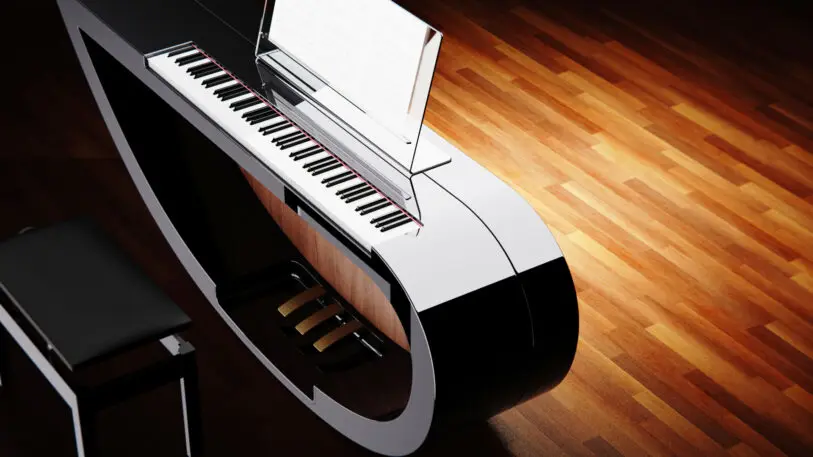Few objects are defined by their shape as much as the grand piano. Inspired by the form of its predecessor, the harpsichord, the piano is the musical embodiment of “form follows function.” It has had the same sinuous body for more than 300 years.
Why reinvent it?

That’s exactly the question I posed to Dan Harden, founder and CEO of the San Francisco-based industrial design firm Whipsaw, who four months ago set out to radically redesign the piano. Harden’s proposal, called the Ravenchord, is shaped like a bird’s wing, with strings fanning out from the center. In a concert scenario, a pianist would sit in front of the piano and face the audience; viewers would get to see the inner workings of the instrument as the pianist plays.
The visual connection is possible because the mechanisms that make up a piano—the hammers, dampers, and strings—are all exposed in Harden’s design. Unlike a violin, or drums, where you can see the bow sliding against the strings, or the sticks hitting the drumhead, a piano is a black box.
“The magic of the instrument is mostly hidden,” Harden says. “I wanted to liberate the piano by more fully expressing its form, function, and usability.” For now, the Ravenchord is just a concept, but the technical drawings are done, and Harden is waiting for an investor—maybe Elton John, he says in jest—to swoop in and turn those drawings into a built prototype.
Harden is far from the first person to attempt to reinvent the instrument. The Schimmel Pegasus, for example, boasts a voluptuous body worthy of Zaha Hadid’s office. The Bogányi piano sports a cantilevered shape reminiscent of a giant Panton chair. Most of these iterations retain the DNA of a grand piano, tweaking it only at the margin. But the Ravenchord is unrecognizable—perhaps because Harden, who doesn’t play the piano, isn’t as attached to the traditional shape of the instrument as I have been since I started playing at age 7. “I don’t think that pianos are very beautiful. I think they’re awkward forms with ugly legs,” he tells me. Touché.

Here I should note that the parts that would completely disorient a pianist if they were altered—the number of keys, the placement of the pedals—remain the same in Harden’s design. What changes is the infrastructure around the keyboard. And it’s not just a matter of aesthetics or better expression. It’s also about sound.

Let’s back up a little. To produce sound on a grand piano, the pianist presses a key, which strikes a hammer, which hits the corresponding string. The vibration generated by that string, aka the sound, is then amplified by the piano’s wooden soundboard before it bounces off the lid and into the surrounding space. An open lid improves the tonal resonance, resulting in a clearer, deeper sound. A closed lid dampens the sound so much that my piano teacher often kept it closed so that whoever snagged the grand piano wouldn’t disturb fellow students next door.
But what happens when the lid disappears completely, like with the Ravenchord? Without a built prototype, it’s hard to predict, but Harden believes the sound will bounce off the Ravenchord’s wooden soundboard and, without a lid to reflect it, come out straight from the back and flow directly toward the audience.
There are other, more pragmatic, benefits, like the idea of a less cumbersome, more portable instrument. Harden envisions the Ravenchord to be about 20% lighter than a grand piano, or about the weight of an upright. Even so, building it won’t be easy. The first challenge will be to create a frame strong enough to withstand the 18 tons of tension that the strings hold. The second will be to achieve the right kind of tone with an untested shape.
The biggest challenge will be to convince pianists that this thing they have known their entire lives, this thing that has become an extension of their fingers, is ripe for reinvention. I, for one, welcome the experiment with infinite curiosity and a touch of skepticism.
Recognize your brand’s excellence by applying to this year’s Brands That Matter Awards before the final deadline, June 7.
Sign up for Brands That Matter notifications here.
